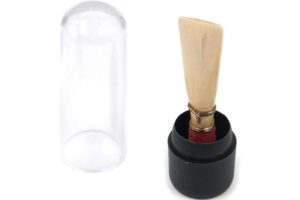Music has the incredible power to move our souls, and behind every captivating melody lies an orchestra of instruments working in harmony.

Among the many components that contribute to the enchanting sounds of woodwind and brass instruments, reeds hold a prominent place.
This blog post will explore reeds, their vital role, and why they can be expensive.
What Are Reeds?
Reeds are thin, flat pieces of material that vibrate to produce sound.
They act as a crucial intermediary between the player and the instrument, converting the player’s breath or air pressure into musical tones.
Reeds are predominantly found in woodwind instruments such as clarinets, saxophones, oboes, and bassoons and in certain brass instruments like the harmonica.
Importance of Reeds
Reeds play important roles in woodwind instruments, serving as the crucial interface between the musician and their instrument. Here are three major importance of woodwind instruments.
Sound Production
Reeds are primarily responsible for initiating sound production in woodwind instruments.
When air is blown or channeled into the instrument, the pressure causes the reed to vibrate rapidly.
This vibration, in turn, generates sound waves that travel through the instrument and produce the desired musical tones.
Each reed’s unique shape, size, and material composition contribute to the distinct tonal characteristics of different instruments.
Tone Control
Reeds play a pivotal role in shaping woodwind instruments’ tonal quality and expressive capabilities.
By adjusting the pressure, embouchure, and airflow, musicians can manipulate the reeds’ vibrations, thus controlling the pitch, volume, and timbre of the produced sound.
The reeds’ flexibility, thickness, and tension can significantly influence the instrument’s responsiveness, allowing musicians to achieve a wide range of expressive nuances.
Articulation
Articulation refers to the precision and clarity with which notes are played in a musical composition.
Reeds have a direct impact on the instrument’s articulation, enabling musicians to execute rapid passages, staccato notes, and complex musical phrases with precision.
How the player interacts with the reed through tongue and finger movements affects the attack, release, and overall clarity of the notes produced.
Factors Influencing the Cost of Instrument Reeds
The cost of instrument reeds can vary depending on several factors. Here are eight key factors that influence the cost of instrument reeds:
Quality of the Raw Material
The cost of high-quality cane contributes to the higher price of reeds. It takes time, effort, and expertise to source the best cane from specific regions.
Reeds are typically made from a specific type of cane known for their suitability in producing high-quality reeds.
The selection process for the cane involves careful evaluation and sorting to ensure that only the best pieces are used.

As such, reeds made from high-quality cane tend to have superior characteristics such as good response, resonance, and durability.
The cane must also meet specific requirements in terms of density, flexibility, and consistency.
In fact, to achieve optimal performance, the selected cane goes through a series of processing steps.
This includes soaking, drying, and aging the cane to ensure its stability and readiness for shaping.
Skilled artisans then shape the cane into reeds, carefully thinning and balancing them to achieve the desired sound and response.
Brand Reputation
The reputation and brand awareness of the maker significantly influence the cost of the instrument’s reeds.
Due to their track record of producing high-quality reeds, well-known brands sometimes charge higher costs due to their reputation for reliability and workmanship.
These companies make research and development investments to improve their production techniques, producing more reliable, long-lasting reeds capable of producing pleasing tonal characteristics.
Instrument Type
Reeds for various instruments must be customized to fit their individual needs.
Saxophone reeds, for instance, are available in a variety of diameters and intensities to accommodate varied playing techniques and musical genres.
Reeds are often more expensive for bigger, more intricate instruments like bassoons or contrabass clarinets than for smaller instruments like piccolos or soprano saxophones.
This is mostly because bigger reeds make use of greater material needs and have production complexity.
Craftsmanship and Labor
Reeds are produced with specialized work and fine craftsmanship.
Therefore, the reeds are frequently shaped, trimmed, and refined by skilled craftsmen or artisans to get the necessary performance qualities.
Likewise, the total cost of reeds may be influenced by the salaries of these skilled laborers, the quality of their work, and their attention to detail.
Quality Control
Reputable manufacturers prioritize quality control to ensure consistency in their reeds.
This involves rigorous testing, selection, and grading of individual reeds to meet specific performance standards.
They place a strong emphasis on maintaining high standards to ensure that every reed meets specific performance criteria.
This dedication to quality control adds value to the reeds but can also impact their price.
The cost of quality control measures, such as testing equipment, skilled personnel, and the rejection of subpar reeds, can influence the final cost of the product.
Limited Supply

Some reed makers deliberately limit the production of their reeds for various reasons.
By controlling the supply, they can maintain a sense of exclusivity and scarcity, which can drive up the price.
When a particular brand or model of the reed becomes known for its exceptional quality or unique characteristics, musicians may eagerly seek out these reeds, resulting in high demand.
However, if the supply is limited, the available quantity may not be sufficient to meet the demand, leading to increased competition among musicians and potentially higher prices.
This scarcity factor creates a sense of value and desirability around these sought-after reeds, making them more expensive than more readily available alternatives.
Packaging and Presentation
The packaging and presentation of reeds can contribute to their perceived value and influence their pricing.
Higher-end reeds often come in specialized packaging designed to protect the reeds and enhance their overall presentation.
This packaging may include features like individual reed holders, protective cases, or personalized containers.
These extra touches serve functional purposes and create an impression of luxury and attention to detail.
Musicians may be willing to pay a premium for reeds that come in such packaging because it adds a sense of exclusivity, professionalism, and care to the product.
The additional cost associated with creating and sourcing these specialized packaging materials is reflected in the higher price of the reeds.
Market Demand
Market demand plays a significant role in determining the price of reeds.
If a particular brand or model of reeds becomes highly sought after by professional musicians, teachers, or influential figures in the music industry, the demand for those reeds increases.
This high demand, coupled with the limited availability of the reeds, can drive up their price.
Musicians often look to renowned professionals and influential figures for guidance on equipment choices, including reeds.
Positive reviews, recommendations, or endorsements from respected individuals can create a perception of quality and prestige around certain reeds, leading to increased demand and higher prices.
As musicians aspire to achieve a similar performance or sound quality level, they may be willing to invest more in the reeds endorsed by their idols or trusted experts, thus driving up the market price.
Takeaway
If you’re wondering why reeds are expensive, these factors are above the major reasons they are expensive.
As such, when investing in a new reed, you should note the above.
While more affordable reeds are available, higher-priced reeds often offer better quality, consistency, and performance, which can greatly enhance the playing experience for musicians.






